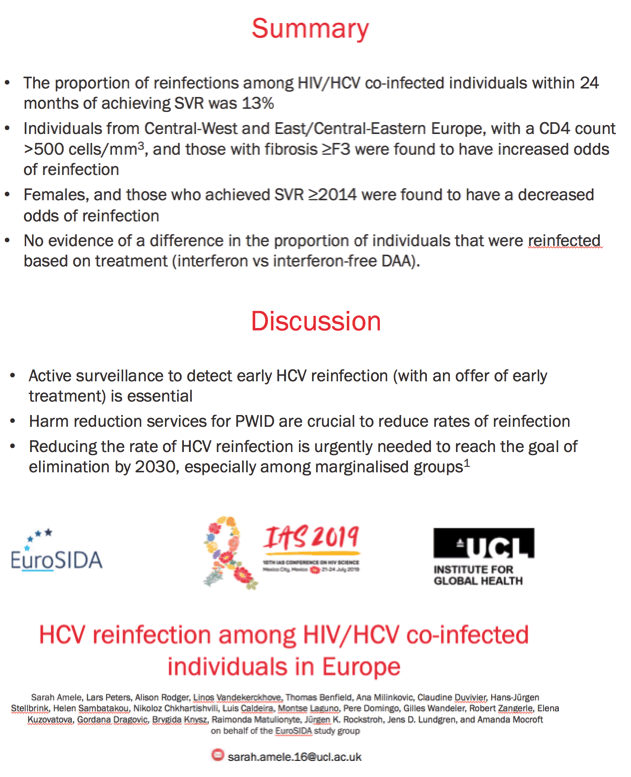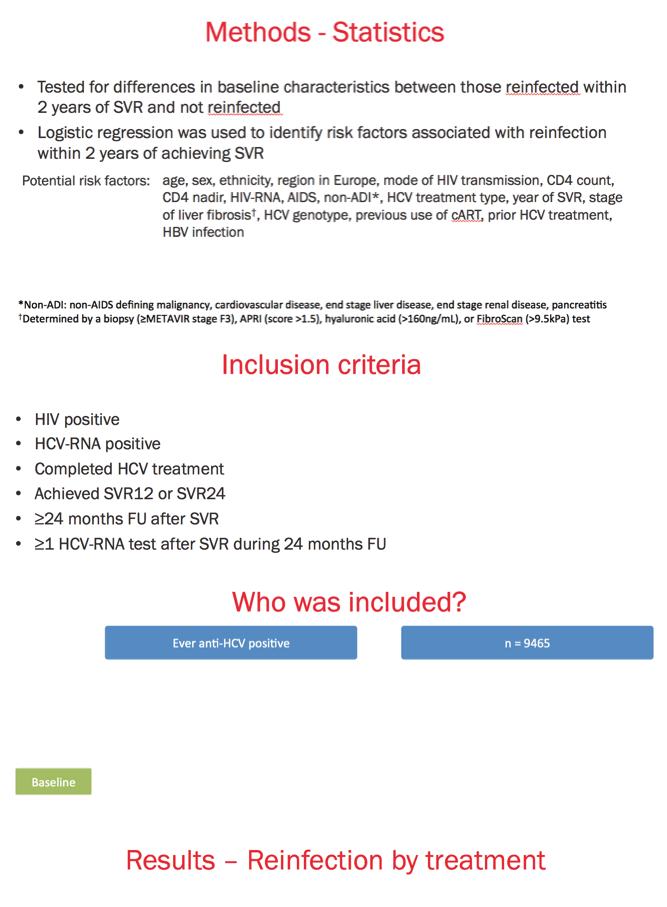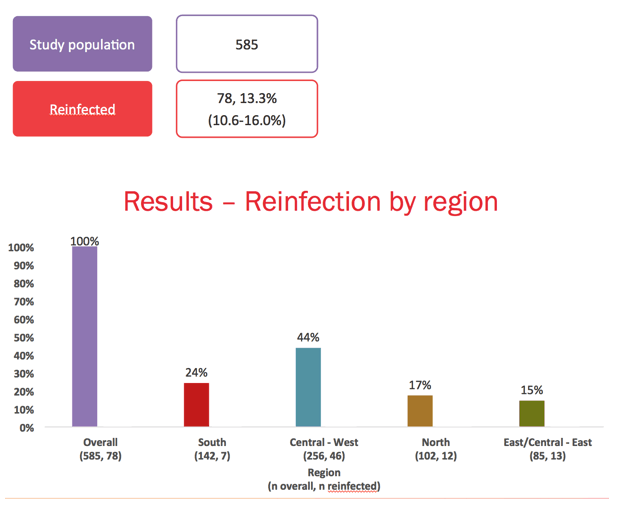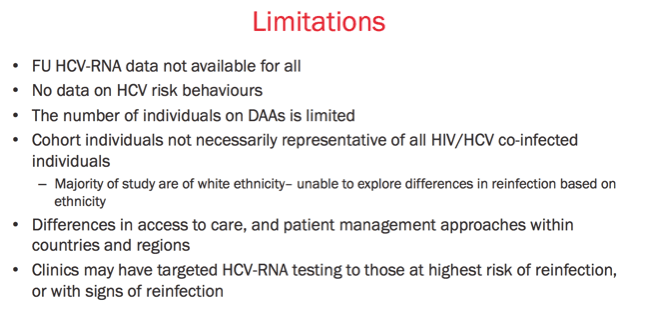 |
 |
 |
| |
HCV Reinfection Rate in People With HCV/HIV 13% Across Europe
|
| |
| |
10th IAS Conference on HIV Science (IAS 2019), July 21-24, 2019, Mexico City
Mark Mascolini
Among people with HCV and HIV in the EuroSIDA cohort, 13% became reinfected with HCV within 2 years of clearing HCV with treatment [1]. The 585-person analysis also found that people in Central-West and Central-East Europe had about 4-fold higher odds of reinfection than people in Southern Europe.
The EuroSIDA investigators noted that direct-acting antivirals (DAAs) can clear HCV in nearly all treated people. But if some cured people become reinfected with HCV, eliminating this hepatitis virus becomes impossible. Evidence suggests that certain groups--HIV-positive men who have sex with men (MSM), HIV-negative men using PrEP, and people who inject drugs--may run a particularly high risk of HCV reinfection [2,3].
EuroSIDA is an ongoing observational study of more than 22,000 people with HIV, most of them in Europe. The researchers defined HCV reinfection as being (1) HCV RNA positive, or (2) being HCV genotyped, or (3) receiving HCV therapy--each within 24 months of sustained virologic response (SVR). They used logistic regression to pinpoint factors independently associated with reinfection within 2 years of SVR.
The analysis focused on 585 people positive for HCV and HIV who completed HCV treatment and remained HCV-negative for 12 weeks after DAA therapy stopped or 24 weeks after interferon-based therapy stopped (SVR12 or SVR24). Everyone had at least 24 months of follow-up after SVR and at least 1 HCV RNA assay after SVR during 24 months of follow-up.
Among these 585 people who attained SVR and got retested for HCV, 78 became reinfected (13.3%, 95% confidence interval [CI] 10.6 to 16.0). The reinfection rate differed little between people who reached SVR with an interferon regimen (13.3%) or with DAAs (13.6%). The reinfection rate was higher in Central-West Europe (18%) and East/Central-East Europe (15%) than in the North (12%) or the South (5%) (P = 0.003 across regions). (EuroSIDA regions are defined on the map at https://chip.dk/Studies/EuroSIDA/About. Central-West Europe includes Austria, Belgium, France, Germany, Luxembourg, and Switzerland. East/Central-East includes countries from the Balkans north to Poland and east to Russia.)
Reinfection rates were significantly higher in males than females (15.0% versus 7.6%, P = 0.0270) and with SVR before 2014 versus 2014 or later (16.3% versus 9.9%, P = 0.0219). Reinfection proved nonsignificantly more frequent in MSM than in people who inject drugs (16.4% and 13.5%, P = 0.1471). Reinfection rates did not differ significantly by type of HCV therapy (interferon or DAAs), fibrosis below stage 3 or 3 or above, HCV genotype (G1 versus others), combination antiretroviral therapy (yes or no), prior HCV treatment (yes or no), age, or CD4 count.
In multivariate logistic regression analysis, gender, year of SVR, region, CD4 count, and fibrosis stage emerged as independent predictors of reinfection within 2 years of SVR, at the following adjusted odds ratios (aOR) and 95% CI:
Lower odds:
Female vs male: aOR 0.46, 95% CI 0.21 to 0.99
SVR year 2014 or later vs earlier: aOR 0.44, 95% CI 0.23 to 0.84
Higher odds:
Central-West vs South region: aOR 3.88, 95% CI 1.66 to 9.07
East/Central-East vs South region: aOR 4.39, 95% CI 1.60 to 12.05
CD4 count above 500 vs lower: aOR 1.74, 95% CI 1.03 to 2.94
F3 or greater vs lower fibrosis stage: aOR 2.41, 95% CI 1.00 to 5.80.
The EuroSIDA team underlined the need for active surveillance to detect early HCV reinfection--backed by an offer of early therapy. They added that harm-reduction services for people who inject drugs are crucial to cutting HCV reinfection rates.
References
1. Amele S, Peters L, Rodger A, et al. HCV reinfection among HIV/HCV co-infected individuals in Europe. 10th IAS Conference on HIV Science (IAS 2019), July 21-24, 2019, Mexico City. Abstract WEAB0303.
2. Simmons B, Saleem J, Hill A, Riley RD, Cooke GS. Risk of late relapse or reinfection with hepatitis C virus after achieving a sustained virological response: a systematic review and meta-analysis. Clin Infect Dis. 2016;62:683-694.
3. Ingiliz P, Martin TC, Rodger A, et al. HCV reinfection incidence and spontaneous clearance rates in HIV-positive men who have sex with men in Western Europe. J Hepatol. 2017;66:282-287.






|
| |
|
 |
 |
|
|